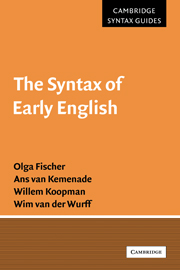Book contents
- Frontmatter
- Contents
- Preface
- List of editions used
- 1 Language change and grammar change
- 2 An outline of Old English syntax
- 3 An outline of Middle English syntax
- 4 The Verb-Second constraint and its loss
- 5 The loss of object–verb word order
- 6 Verb–particles in Old and Middle English
- 7 Changes in infinitival constructions
- 8 The history of the ‘easy-to-please’ construction
- 9 Grammaticalization and grammar change
- References
- Index
2 - An outline of Old English syntax
Published online by Cambridge University Press: 23 December 2009
- Frontmatter
- Contents
- Preface
- List of editions used
- 1 Language change and grammar change
- 2 An outline of Old English syntax
- 3 An outline of Middle English syntax
- 4 The Verb-Second constraint and its loss
- 5 The loss of object–verb word order
- 6 Verb–particles in Old and Middle English
- 7 Changes in infinitival constructions
- 8 The history of the ‘easy-to-please’ construction
- 9 Grammaticalization and grammar change
- References
- Index
Summary
Introduction
The aim of this chapter is to give a descriptive overview of a number of important features of the syntax of Old English, i.e. English from the earliest texts (c. 800) to about 1100. The material in this chapter is primarily based on the evidence from the two main bodies of prose text in Old English: the prose of King Alfred (ninth century) and that of Ælfric, abbot of Eynsham (tenth century). In the final section of the chapter, we will touch on some of the ways in which the syntax of the prose differs from that of the Old English poetry.
Old English is the language imported into the British isles by the immigrations from the continent in the fourth, fifth and sixth centuries. It therefore evolved from a number of continental West Germanic languages/dialects. The syntactic study of Old English can be reliably based only on one dialect: the West Saxon standard written language or Schriftsprache, in which the bulk of Old English writing has come down to us. There is little scope for work on dialect syntax in Old English; almost all the texts are in the West Saxon dialect, while those works of any length that were not written in West Saxon consist mostly of interlinear glosses on parts of the Vulgate bible, and are therefore of limited use for syntactic purposes. We will nevertheless be commenting upon those aspects where they do prove revealing, which is mostly in those cases where the gloss deviates from the original.
The view of Old English presented in this chapter should be seen as a digest of the consensus view in the literature.
- Type
- Chapter
- Information
- The Syntax of Early English , pp. 37 - 67Publisher: Cambridge University PressPrint publication year: 2001

